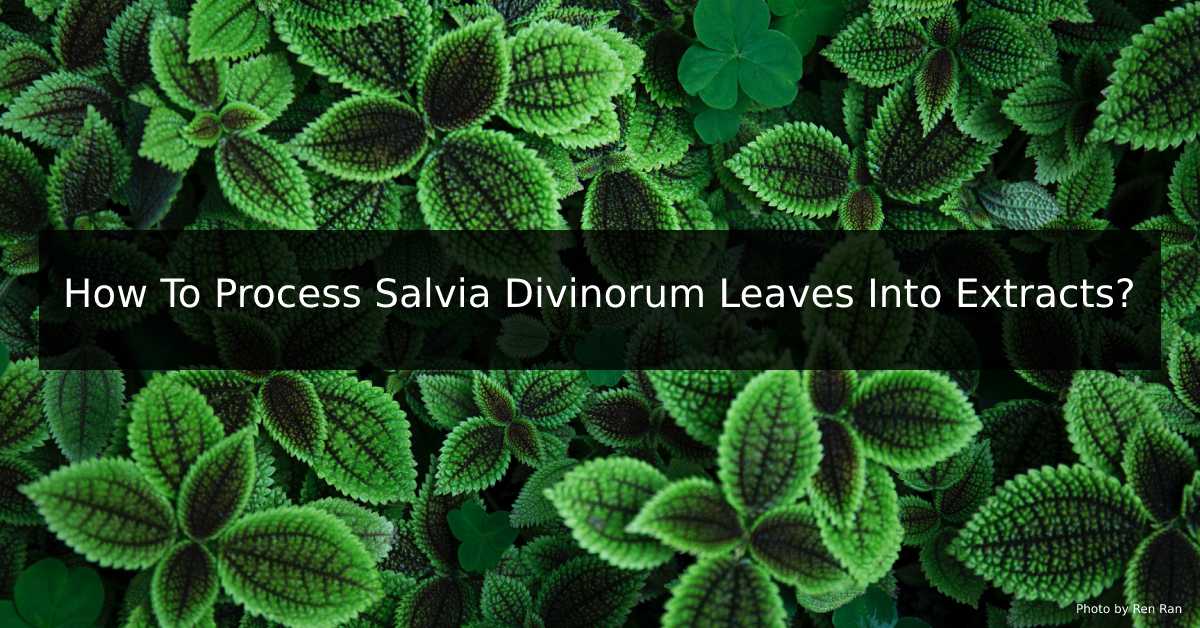Salvia Divinorum is a very popular herb from the mint family that is native to southern Mexico, South America, and Central America. The leaves of this plant contain Salvinorin A, which has psychoactive properties. It can cause dizziness, hallucination, and paranoia in many cases.
Salvia is typically sold as a dried leaf in the market. However, you can make its extracts at your home through a very easy process. The Salvia leaves extracts are very potent that can be made into 10x, 20x, 40x, or up to 60x extracts.
Making Salvia Divinorum leaves extracts at home is an interesting process that is quick, easy, and practical. This process is divided into two major stages. We will use water in the first stage, while the second stage involves acetone as a solvent. So wear your apron, put on a toque, and go straight into the kitchen.
Salvia Divinorum Leaves Extracts
Ingredients
- Salvia divinorum leaves – 100 grams
- Distilled water – 4 litres
- Acetone – 2 liters
Dishes and Tools:
- A baking dish
- A dish for evaporation
- Wire strainer
- 2 Glass mason jars (1 Liter each)
- A mixing glass bowl
- Cheesecloth
- Aluminum foil
- Coffee grinder and coffee filters
Ensure that all the crockery you use is made of glass. Since this process involves the use of acetone, it will dissolve the plastic. We need to stay on the safer side while using acetone.
Salvia Divinorum Leaves Extracts – Procedure
Stage 1
In this stage, we will soak and finally dry out the Salvia leaves. You need nothing other than 100 grams of leaves and 4 liters of cool distilled water. Let’s see the step-by-step procedure.
Step 1 – Crush the Leaves
Crush the leaves as fine as you can with your hands. You shouldn’t use a coffee grinder in this step. Do it solely with your hands.
Step 2 – Soak the Leaves
Take a glass bowl and add leaves to it. Now pour cool distilled water into it and leave it for at least 10 minutes. Ensure that the leaves are all submerged in the water.
Step 3 – Separate the Soaked Leaves
Cheesecloth comes in handy when separating leaves from the water. Make sure you squeeze out all the water from the leaves.
Step 4 – Dry the Leaves
Take out the baking dish and spread all the leaves on it. We will put the dish in the oven at 100-degree Celsius for several hours. The leaves have to stay there until they are completely dried. Don’t forget to turn the leaves time by time. This will catalyze the drying process. Once the leaves are dried, take them out of the oven and let them cool down to room temperature.
Step 5 – Decide the Strength of the Extracts
From a total of 100 grams of leaves, you need to separate out a certain concentration depending on the strength of the extract you are going to make. Just to give you an idea, 20 grams of leaves will make a 5x extract, 10 grams for a 10x, and 5 grams for a 20x extract.
Step 6 – Grind the Leaves
Here comes the need for a coffee grinder. Once you select the strength of extract you want to make, take that amount of leaves accordingly and put them in the grinder to turn them into a fine powder. Keep the rest of the leaves aside that we need further in the process.
Stage 2
This step is all about handling acetone. Since acetone is a highly flammable chemical, you need to do all this work in a highly ventilated environment away from a stove and fire. Make sure you use glass dishes and completely avoid plastic in the forthcoming steps.
Step 7 – Add the Leaves into Mason Jar
The leaves will go into the mason jar along with acetone. Ensure that you have enough acetone to cover the leaves fully. Once you are done, cover the lid. Use aluminum foil or a piece of clean cloth to cover the top of the mason jar, then close the lid. This is essential to prevent the acetone from touching the plastic lid.
You need to let the mixture sit for a day. Open it after a few hours to give it a quick mix using a stirrer.
Step 8 – Shift to the Second Jar
Now bring out a strainer and place a coffee filter in the strainer. Pour the solution from the first jar into the second one using the strainer.
Step 9 – Repeat the Process
The strained acetone will be in the second jar now. Pick the leaf that is left behind and add it back into the previous jar. Pour more acetone on it and again leave it for 24 hours. Finally, strain it into the second jar.
Continue with pour, rest, and strain for the third time as well. The heavenly Salvinorin will already be out by now.
Step 10 – Let the Acetone Evaporate
Bring out the baking dish (made of glass) and pour the acetone on it. Leave it in the open until a total of 250 ml acetone is left behind.
Step 11 – Add the Powdered Leaves
Once you have 250 ml acetone left behind, add the powdered leaves to it and let it evaporate again.
Step 12 – Evaporate more Acetone
Let the acetone evaporate until you see none from your eyes. At this point, take a few more tablespoons of acetone and add to the dish again and let it evaporate as well. Stirring is crucial in this step as it will keep the resin from accumulating.
Let the acetone dry completely, so you are left with Salvia divinorum leaves extract of your desired strength. Let the acetone dry for a few more days until there is no chemical left behind.
The extract will be ready to smoke after a day or two. The effects will be different depending on the strength of the extract. A 5x extract will definitely have potent effects.



